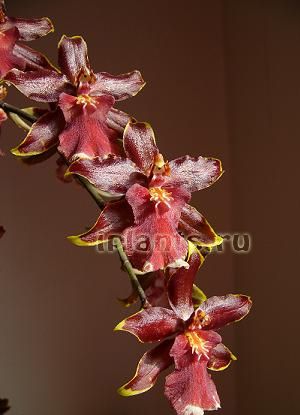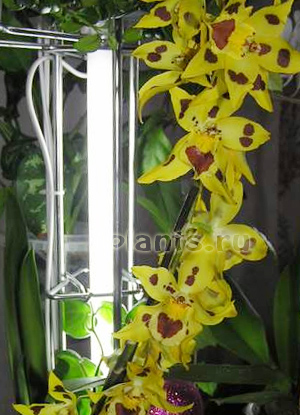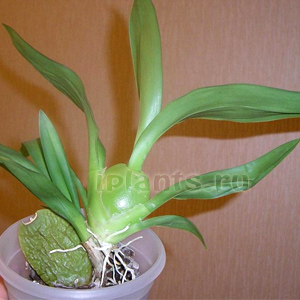Orchid family. Cumbria, this is not the name of the genus, but the name of the hybrid, which came from the crossing of various species of orchids. For example, Vuylstekeara Cambria "Plush," simply abbreviated as Cambria by flower sellers and suppliers, is a hybrid of the genus "Vuylstekeara," derived from the crossbreeding of orchids of the Cochlioda genera Cochlioda x Miltonia Miltonia x Odontoglossum Odontoglossum. Although, Cumbria is more correct, the generalized name of complex hybrids, as a participant in our forum noted, to make life easier, because the pronunciation of a hybrid of Vailstekeara, or Calmanara, Burrageara, is too difficult for any language.
These are sympodial orchids, having developed bulbs, oval flattened or elongated spindle-shaped, usually carrying 2-3 leaves. The leaves, sitting tightly to each other, are broadly lanceolate, up to 50 cm long, dark green in color, with a pronounced central vein. The flowers are large, about 7-10 cm in diameter, the petals are red (to the bard) interspersed with white, the lip is wide, red at the base and white from the middle with red specks.
 'Wildcat Bobcat'Credit: sunfleur
'Wildcat Bobcat'Credit: sunfleur CumbriaCredit: Freya
CumbriaCredit: FreyaCumbria care
Temperature: Cambria is moderately heat-loving, in summer the optimal temperature is about 22-26 ° C, it is desirable that the night temperature difference is about 4-6 ° C. In winter, cool content at 16-18 ° C.
Lighting: Requires bright but diffused lighting. In summer, it can be kept on the north window or on the east windowsill, where the sun pleases, but does not burn. In autumn and winter, if flowering continues, daylight lamps may be needed.
Watering: Hydration of the substrate should be regular but moderate. Cambria roots should not stand in water, so it is desirable that the pot has many holes on the bottom and walls. It is necessary to water when the substrate in the pot dries completely after the previous watering, that is, the bark inside the pot will also be dry. It is better to water cambria by immersion, avoiding getting wet with rice.
When watered by immersion, a pot of cambria is lowered for 10 minutes into a basin or bucket of warm, soft (boiled) water. Then you need to get the pot, wait for all the water to drain and put it in place. It should be borne in mind that at the bottom of the pot (and in the walls) there should be frequent and large holes (1-1.5 cm). The frequency of irrigation depends on the air temperature and moisture capacity of the substrate. For example, if temperatures are above 24 ° C once every 5 days, if about 20-22 ° C once every 7-10 days.
Fertilizer: During the growth period, they are fed with special fertilizer for orchids once every two weeks during irrigation by immersion or spraying on a sheet. Cumbrias are very sensitive to salinization of the substrate, so it is better not to feed them than to feed them with fertilizer.
Humidity: Cumbria is less demanding on high humidity than many other orchids, but it is better to pollinate the air around the leaves once a day with soft water on hot, dry days. If the room is very warm (over 28 ° C), then you can spray twice a day, but make sure that water does not flow into the substrate in streams.
Transplantation: Transplantation is carried out when the need arises:
- orchid roots begin to crawl out of the pot, and the plant slows growth
- decomposed and turned into dust substrate from bark
- decay appeared, the bark was covered with mold
- you just bought a plant in an unknown substrate or at a markdown
If cambria has been growing for a long time, then the transplant should be timed to coincide with bright spring days in March or after flowering. Cambria soil: a mixture of pine bark and fern roots. The fraction is large cubes of bark with a side of about 1.5-2 cm. Since fern roots are a big problem to get, you can take pine bark and pieces of foam in half. No need to add sphagnum moss, but you can coconut chips (shards from coconut shells) or forest moss (which is tough, not hygroscopic, dries like wire). To prevent the orchid pot from falling, put one or two large stones on the bottom of it.
It is not advisable to plant cambria and hybrids in the soil for orchids from a store (where peat, sand, moss, etc.), or in ordinary peat soil. Cumbria is an epiphyte, like other orchids, the roots must breathe! During landing do not cover the basal part of bulbs with substrate.
After transplanting, do not water the orchid for about 5 days. Cambria is very averse to substrate salinity. Therefore, if a white coating appears on the bark, then it needs to be changed, and boil water for watering or use a filter to soften the water.
Reproduction: Dividing the bush during transplantation. Reproduction is painlessly possible if at least 3-4 bulbs remain on the mother plant. Separated children should be planted exactly as described above for adult plants, only a smaller pot.

